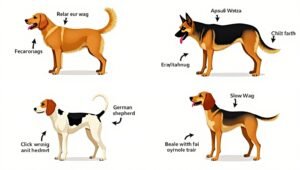Dogs don’t have words, but they are always talking to us—using body language. As a UK dog owner, it’s one of the most potent tools for enhancing your relationship, avoiding behavioral problems, and keeping your dog safe and heard.
In this guide, we will break down the important dog body language signs—wagging tails to flat ears—so you can see what your pup is trying to communicate.
Why Dog Body Language Matters

Knowledge of body language is crucial to being a good dog owner. Dogs communicate emotions such as happiness, fear, stress, or excitement using physical cues. When these cues are misread or disregarded by the owners, it can result in:
- Behavioral problems.
- Anxiety in dogs.
- Missed signs of distress or illness.
- Increased risk of bites or aggression.
Whether you’re walking through Hyde Park, visiting the vet, or just playing at home, knowing how to read your dog’s cues can prevent misunderstandings and build deeper trust.
Key Dog Body Language Signals and What They Mean
1. Tail Position and Movement

Dogs speak volumes with their tails.
- Wagging tail (mid-height): Friendly and happy.
- Tail tucked between legs: Afraid, nervous, or submissive
- High and stiff tail: Alert or dominant-feeling.
- Slow wag with stiffness: Suspicious, perhaps a threat.
Note: The wagging tail doesn’t always indicate a happy dog—consider the entire body posture as well.
2. Ear Position
Ears stand differently on each breed, but the movement does tell a tale.
- Ears forward: Attentive, alert, or inquisitive.
- Ears flat against head: Fearful, nervous, or submissive.
- One ear up, one down: Confused or trying to get something into perspective.
UK Tip: If your dog’s ears flip back and forth constantly in noisy situations such as London roads, it might be overwhelmed by stimulation.
3. Eye Contact and Expression
- Soft, blinking eyes: At ease and relaxed.
- Staring or wide-open eyes: Paying attention or threatened.
- Whale eye (seeing the whites): Apprehensive or protecting a resource.
- Squinting or avoiding eye contact: Fear or discomfort.
Observe pupil dilation under high-stress scenarios—it might be an indicator of increasing anxiety.
4. Mouth and Facial Expression
- Relaxed, slightly open mouth: Calm and relaxed.
- Panting with a relaxed face: Delighted or cooling off.
- Tightly closed mouth or lip licking: Nervousness, stress.
- Snarling or growling: Warning sign—dog is threatened.
Dogs will lick their lips or yawn when they are in distress, particularly in unfamiliar social environments.
5. Body Posture
Your dog’s stance reveals their mood.
- Loosely wiggly body: Friendly, happy, and welcoming.
- Forward weight, stiff body: Challenging or restrained.
- Lowered body or cowering: Submissive or fearful.
- Back on its back with belly exposed: Submissive—or soliciting tummy rubs if relaxed.
Note: Context is everything—some dogs expose their belly when anxious instead of inviting affection.
6. Vocal Signals
Although not body language in itself, your dog’s sounds can reinforce what their body is communicating.
- Whining: Fearfulness, discomfort, or attention-seeking.
- Barking: Excitement, fear, alarm, or command.
- Growling: A warning—don’t ignore this signal.
- Howling: Communication or response to specific sounds.
How to Respond to Your Dog’s Body Language
An able response to body language is just as important as understanding it.
- Respect boundaries: Don’t force interaction if your dog is showing signs of fear or discomfort.
- Reward calm behavior: Use treats or praise to reinforce relaxed postures and expressions.
- Provide space and quiet: For anxious or overstimulated dogs, a break from noise or people can work wonders.
- Avoid punishment: Growling, barking, or cowering are signs of communication, not bad behavior.
Situational Awareness: UK Scenarios
Lifestyle in the UK brings certain settings where canine body language is particularly relevant:
- Public transport (e.g. London Underground): Dogs can be stressed—look for signs such as panting or lip licking.
- Fireworks (Bonfire Night, New Year’s Eve): Tail tucking, shaking, and hiding are usual—set up a secure, quiet area.
- Parks and off-lead areas: Dogs can feel threatened by strange dogs—observe their posture prior to approach.
When to Seek Professional Help
If your dog consistently exhibits signs of stress, fear, or aggression, it might be time to see:
- A UK-registered dog behaviourist (consult the Association of Pet Behaviour Counsellors—APBC).
- Your local vet can eliminate medical reasons.
- Positive-reinforcement trainers need to change their behavior.
Last Words: Listen with Your Eyes
Reading dog body language is all about paying attention to what your furry friend is attempting to tell you. It strengthens your connection, aids in effective training, and avoids undesired behavior.
So the next time your dog glares at you, wags their tail in a particular manner, or shows a hint of a yawn, stop for a moment and “listen.” You may be amazed at just how much your dog is already telling you.
Subscribe to more expert guides, product reviews, and training tips for UK dog owners. Because the better we know our dogs, the better lives we can give them.
